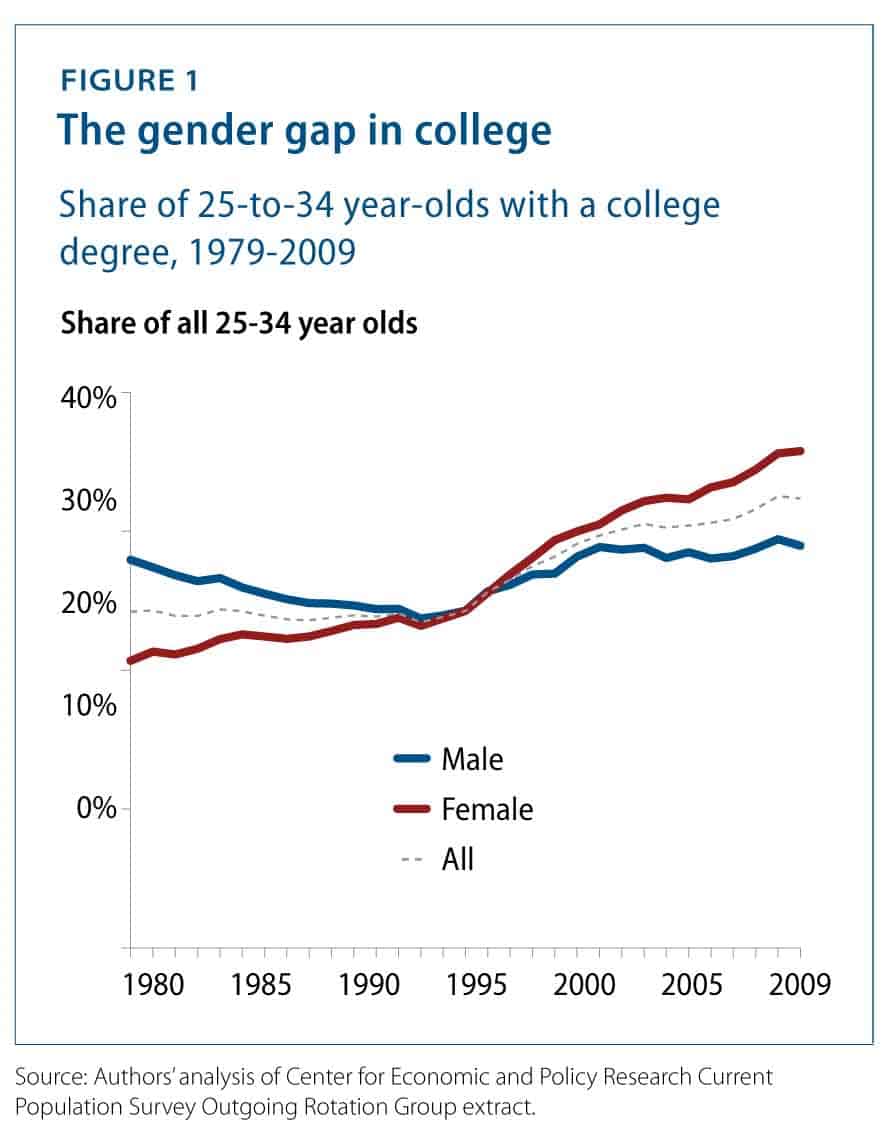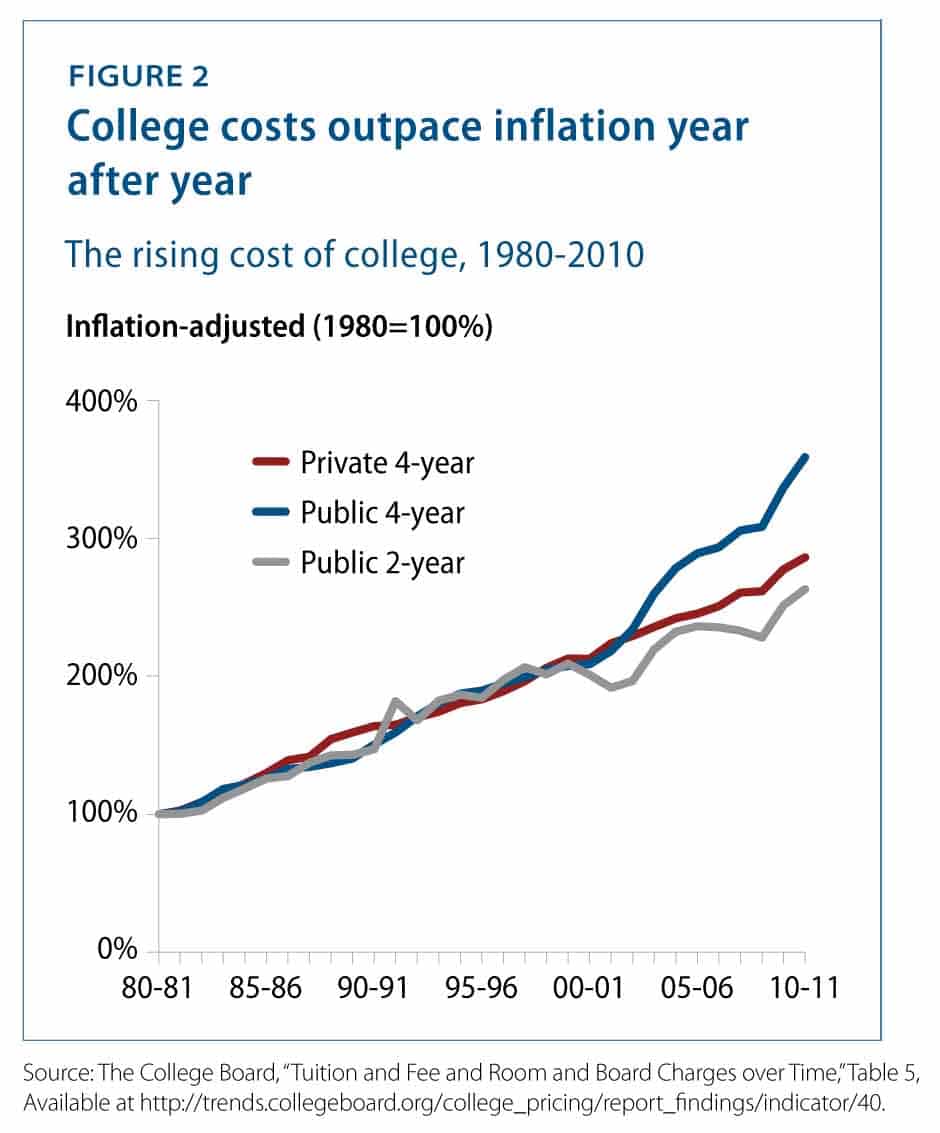Excerpt (Endnotes Omitted):
   |
At least since the early 1990s, the share of young people earning a four-year college degree has not increased as quickly as many economists would like. A higher share of young people today have college degrees than at any point in our nation’s history, yet many economists remain concerned that the supply of college graduates is not keeping pace with what they see as an accelerated demand for the skills taught at college. This college gap seems particularly large for young men, who are now substantially less likely than young women to earn a four-year college degree.
Economists measure the accelerated demand for higher skills by looking at the change in wages of workers with different skills. Over the last three decades, the earnings of college graduates increased sharply relative to the earnings of workers with only a high school degree. Among 25- to 34-year-olds, for example, a college graduate earned 25 percent more than a high school graduate at the end of the 1970s, and by the late 2000s, the pay premium for college graduates in the same age range climbed to 60 percent.
Standard economic theory would predict that such a large increase in relative pay for college-educated workers would lead more and more young people to start and finish college degrees. Yet the share of all 25- to 34-year-olds with a four-year college degree or more changed little in the 1980s, even as the financial return to college increased sharply (see Figure 1). This flat trajectory for all 25- to 34-year-olds is the result of counteracting trends for women and men. Over the 1980s, the college share increased for women, even as the share of 25- to 34-year-old men with a college degree fell noticeably.
In the early 1990s, the overall college-attainment rate began to rise as the college share for women accelerated considerably and the share of college-educated men reversed course and rose through most of the decade. And in the 2000s, the overall college share continued to grow. Women’s college attainment continued to rise at a steady yet slower pace than the late 1990s, but there was almost no change over the decade in the share of 25- to 34-year-old men with a college degree.
These historical trends present economists with two college conundrums. The first: Why haven’t young people responded to higher returns to college by rushing to attend college? The demand side of the market is sending a clear price signal that there are much higher earnings for college-educated workers to be had upon graduation, but the supply side has responded only haltingly. College completion rates are up, but not very much. The second conundrum: Why have men, who are receiving the same signals as women, lagged particularly far behind?
Almost by definition, increasing college completion involves getting students that in the past would not have attended college or who would have attended, but not completed college, to do so. To understand why college completion has not risen as fast as economic models might predict, we need to focus on the students who might, if conditions were slightly different, attend college. These students are wavering between going to a four-year college, attending community college, or entering the labor force immediately. They are on the fence for a variety of reasons. Maybe they did not have the highest grades in high school. Maybe they have work or family responsibilities. Maybe they feel that they cannot afford college.
Whatever the case, for many of these potential students the most relevant reference point may not be the experience of high fliers or even the average college graduate, as economists looking at the data tend to assume. Financial returns from a college education vary widely across graduates, and the gap between the highest and lowest paid graduates increased somewhat over the last three decades. Students on the fence about college may look more to the experience of recent graduates who are earning less than the average college graduate.
Indeed, we find that for many young people, the economic case for attending college may not be as clear cut as it appears based on the experience of the average graduate. For those college graduates at the middle and top of the postcollege pay scale, college in hindsight looks like a sound investment, but not all graduates do this well. And a small but important share of graduates actually do no better than their counterparts who left school after high school — even before taking the costs of college into account. In 2009, for example, our analysis of the Current Population Survey Outgoing Rotation Group extract finds that among 25 to 34 year old men, one-in-five (19.4 percent) who had a college degree actually earned less than the average male high school graduate, as was also the case for one-in-seven women with a college degree (14.0 percent).
The private decision that the wavering student makes not to attend college may be rational for that individual, but it still may be that we would be better off as a society if students on the fence actually went to college. But to get these students to attend (and complete) college, we have to make that socially sensible decision work for individual students as well. The role for policy is to lower the cost (including the debt burden) and to raise the financial benefits to college for these students who are on the margin between college and work.
In this short overview, we first review some possible answers to these two puzzles and then discuss some implications for policy. At this stage, our explanations are tentative and our policy discussion is intended primarily to help focus attention on addressing the market obstacles to increasing participation in postsecondary education, among American males in particular.
Full Text:
Heather Boushey is Senior Economist at the Center for American Progress. Her research focuses on employment, social policy, and family economic well-being. She co-edited The Shriver Report: A Woman’s Nation Changes Everything (Simon & Schuster ebook, 2009) and was a lead author of “Bridging the Gaps,” a 10-state study about how low- and moderate-income working families are left out of work support programs. John Schmitt is a Senior Economist at the Center for Economic and Policy Research. He is a co-author with Lawrence Mishel and Jared Bernstein of three editions of The State of Working America (Cornell University Press) and most recently editor with Jerome Gautier of Low-Wage Work in the Wealthy World (Russell Sage Foundation). This article was published by the Center for American Progress in December 2010; it is reproduced here for non-profit educational purposes.
| Print
